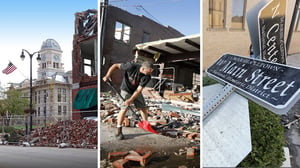On July 19, 2018 tragedy struck the City of Marshalltown.
An EF3 tornado, with winds reaching 144 miles per hour, tore through nine miles (1,000+ feet wide) of the Iowa-based City – leaving devastation to hundreds of homes, local businesses and the City’s town square. Ten residents suffered minor injuries. Miraculously, there were no casualties.
Some of the worst damage was to the courthouse, which had its steeple sheared off, and to the brick buildings that line the City's historic downtown. The City spent nearly two decades transforming these buildings, seeking to make the downtown area a more accessible, inviting and economic destination.
It took just three minutes for the tornado to undo years of work.
Since 2002 we've spent $50 million in building renovations... We were making giant strides in restoring the downtown so this is really devastating to us because we were on a roll. These buildings were beautiful.
– Jenny Etter, executive director, Marshalltown Central Business District
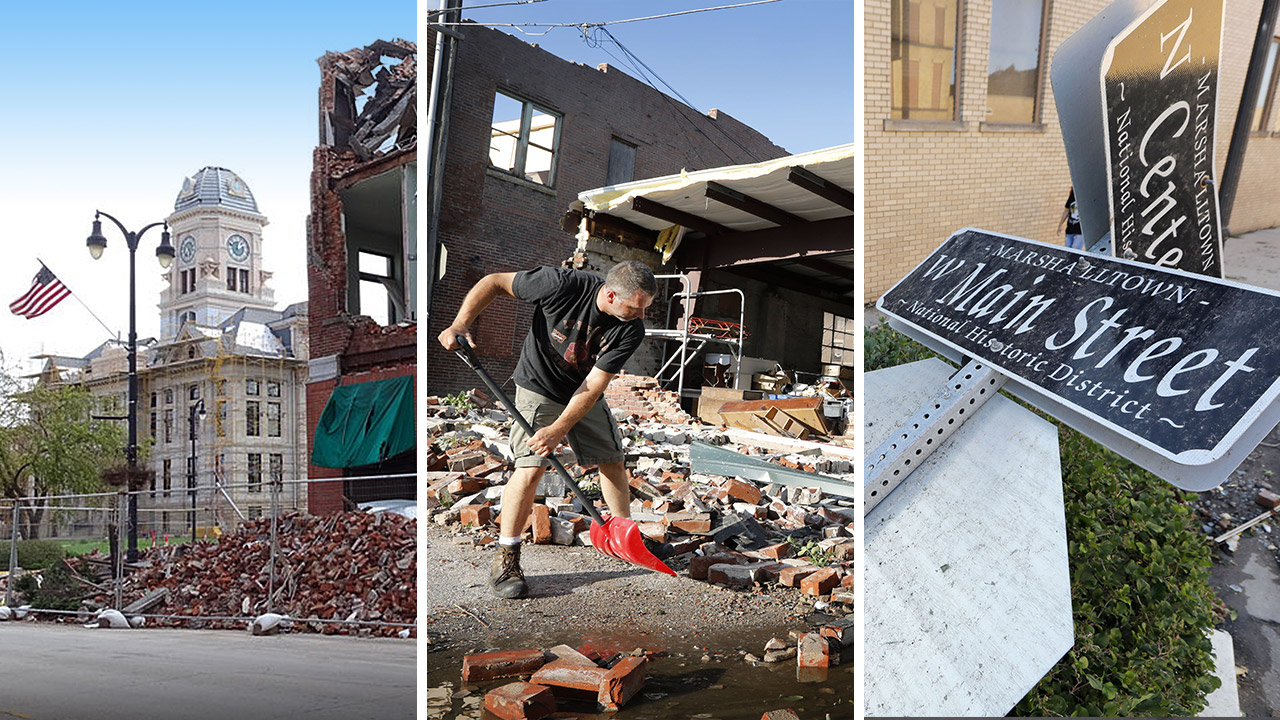
The City and its 27,000 residents were suddenly and without warning left to pick up the pieces. And yet, in the face of tragedy, Marshalltown remained steadfast and resilient; a testament to the will of the community and unquestionably warranting the City’s uniting #MarshalltownStrong hashtag.
Throughout this article, we share how the City of Marshalltown has begun rebuilding after an unexpected natural disaster. The immediate recovery depended on the swift, heroic and generous response of thousands. The City’s long-term rebuilding efforts similarly required collective action in order to create a strategic and actionable master plan in just six months’ time.
The recovery process
Immediately after the mid-summer 2018 tornado, community leaders, emergency responders and volunteers from within and outside the City banded together to ensure the safety of local residents and to support immediate cleanup efforts. The next priority was, “How do we rebuild?” Community leaders recognized a vital step in this process was a new Downtown Marshalltown Master Plan (view the newly adopted master plan in full here, published July 2019).
It truly is remarkable how quickly and effectively the community rallied to marshal the energy and resources necessary so they could begin the immediate cleanup and long-term rebuilding efforts. To witness it first hand was awe-inspiring.
– Lucas Casey, SEH business and community development director
Local officials wanted to begin the rebuild quickly, but also in the most strategic manner possible – making sure all planning and rebuilding efforts prioritized the long-term future, safety and growth of the City, the local economy and community residents.
In September 2018, the Martha-Ellen Tye Foundation – a local philanthropic, voluntarism and grant-making foundation – voiced their support for recovery and redevelopment by committing $100,000 to create a downtown master plan. The U.S. Economic Development Administration matched this funding through a $100,000 Economic Assistance grant of their own based on Marshalltown's downtown being deemed an Opportunity Zone.
With funding in hand, the City began the master planning process.
Developing a steering committee
The City developed a 17-person steering committee consisting of City Council members, Chamber members, local business owners, regional planners and other key stakeholders to help guide decision making during the master planning process. All 17 committee members had a vested interest in Marshalltown’s future and were selected for their expertise, local knowledge and ability to represent the best interests of the community.
Selecting an A/E consultant with the right expertise
The steering committee recognized they needed a partner that shared reverence for the City’s history and growth needs, and was sensitive to how the natural disaster had impacted the community. They also recognized the need for a partner with experience in timely and urgent master planning. Their request for proposal (RFP) and interview process integrated this need throughout the selection process.
In addition, public involvement was paramount to the City's efforts of coming up with a strategic and long-term master plan, especially after an event like a tornado which impacted the entire community. It was important to identify potential consultants who had a defined and tested process for bringing the community into the fold. How can you do this?
During the RFP or interview process, ask consultants how they engage and involve community members. Does their public involvement process include resident surveys, an interactive design process or public meetings? How will they report on and evaluate survey and meeting results? Do they have testimonials or specific examples to share? In what ways will they make sure the voice of the community is heard? Do they have a defined process for engaging all demographics?
The primary challenge for all parties involved was the six-month timeline, as master plans often take 9-12 months if not longer to create. In light of the City’s devastation, missing this timeline wasn’t an option. For this to be possible the steering committee needed to be hands on from day one; to be involved in the consultant team’s efforts so that the master plan was not “outsourced” in any sense, but rather owned and understood deeply by the stakeholders who would be using the plan.
As an example, SEH led the master planning process, including keeping a regimented budget and schedule. SEH also led engagement activities and historical research, brought master planning expertise and proposed technical solutions (as discussed below). Yet, decision making was put on the shoulders of the steering committee. The steering committee invested from day one, made commitments and kept them, and showed up to all important meetings, gatherings and presentations.
One reason master planning often takes much longer than six months is because key stakeholders miss important meetings, fail to show up to public involvement gatherings and fall behind in other ways. Simple perhaps, but things like this can lead to lack of consensus when making decisions, delayed decision making and uninformed decision making – each of which contribute to project delays and master plans that are less than they could be.
3 keys to creating a master plan in 6 months
1. Ask and answer: What does the community need?
Communities often hire A/E firms to research and develop master plans without significant, hands-on involvement from the leadership within these communities and the community as a whole. In a sense, the process is outsourced. Without the impassioned involvement of the Marshalltown steering committee, and beyond that the involvement from residents and other key stakeholders, the master plan could not have been completed in such timely fashion or reached its potential.
One unique example: to establish and uncover key concerns, needs and interests of the community, Marshalltown and SEH led a series of engagement activities over the course of the six-month master planning process. More than 1,500 City residents provided meaningful input throughout these activities. The results of these can be found on the Downtown Marshalltown Master Plan website. These engagement activities included:
- Interactive project website featuring project documents, timeline, event and meeting details, meeting and survey results, master plan progress and more. This website was developed by SEH as part of the planning process and remained active until October 2019. All project website features, documents, as well as meeting and survey results have been transferred to the Marshalltown website hyperlinked above.
- Online community survey asking questions such as “How supportive are you of City investment in downtown revitalization projects?” and “Do you feel safe downtown?” (view the results here)
- Online WikiMapping survey allowing residents to share location specific feedback about downtown Marshalltown. This enabled residents and City staff to map out a variety of insights such as favorite destinations and safety concerns. (view results here)
- 5 downtown steering committee meetings to provide updates and progress, timeline, community involvement feedback and results, looks ahead and more. Recaps of these meetings were placed on the Downtown Marshalltown Master Plan website for ease of access, to ensure transparency and to keep the public informed. (view meeting recaps here)
- 4 focus group meetings facilitated by planning and design consultants to gain an understanding of forces, issues and opportunities surrounding downtown Marshalltown. Attended by community organizations, local business and property owners, local Hispanic business and property owners, banks and land developers. (view summary and meeting results here)
- Multi-day community planning charrette. Inclusive, hands-on and collaborative planning process that relies on the talents and energies of citizens, decision makers and designers. In brief, charrettes serve as an opportunity to inform, engage and elicit meaningful feedback from the community and key stakeholders. (view the charrette intro presentation here, more below)
- 12 confidential interviews held to gain feedback and constructive criticism from key stakeholders within the community; identities were kept confidential to inspire honesty and transparency.
- A community-wide open house held to introduce the drafted Downtown Marshalltown Master Plan, answer questions, and further provide transparency and roadmap for the months/years ahead; multiple presentations were scheduled over seven hours to accommodate the varying schedules of community residents.
The core pivot points of the master plan – the ‘catalyst’ initiatives, the revitalization frameworks, and the interim design standards – were developed with incredible amounts of local knowledge and passion from residents and stakeholders. Combining and harnessing community input with the expertise of SEH’s multidisciplined team and professionals resulted in a plan that is poised to guide great things in downtown Marshalltown.
– SEH arborist and landscape architect
2. Multi-day community planning charrette
One strategy from the bulleted list above that made insight gathering and subsequent plan drafting possible was the four-day community planning and engagement charrette. In February 2019, 10 SEH team members embedded themselves in the Marshalltown community for a week – seeking to gain deeper insight into the concerns, needs and interests of City residents.
The purpose? Listen to the community and get to know the City in order to better plan for its future. These team members stayed at a downtown boutique hotel, ate at the local cafes and got to know the true identity of Marshalltown from the mouths and minds of local residents.
Actionable Tip: Meeting All Audiences
Charrettes and other feedback-oriented activities like public outreach and engagement are most meaningful when all voices are heard. When master planning, consider the demographics of the entire community to ensure you’re reaching all audiences. Twenty-five percent of Marshalltown’s population is Spanish-speaking.
With this in mind, the SEH team included an expert planner/engineer who is Latino and fluent in Spanish. He was instrumental to the charrette and master planning processes – making sure the process was accessible to the Hispanic community and bringing valuable feedback to the final master plan.
The team’s interactive charrette techniques relied on the knowledge and aspirations of community members. They used this knowledge to explore, evaluate and ultimately decide on a suite of integrated policies, plans and projects for the master plan that would be used to guide future community growth. Without becoming “part” of the community, working within the community and engaging 1,500+ City residents, the team could never have helped glean the insight needed to develop a plan that truly serves Marshalltown stakeholders.
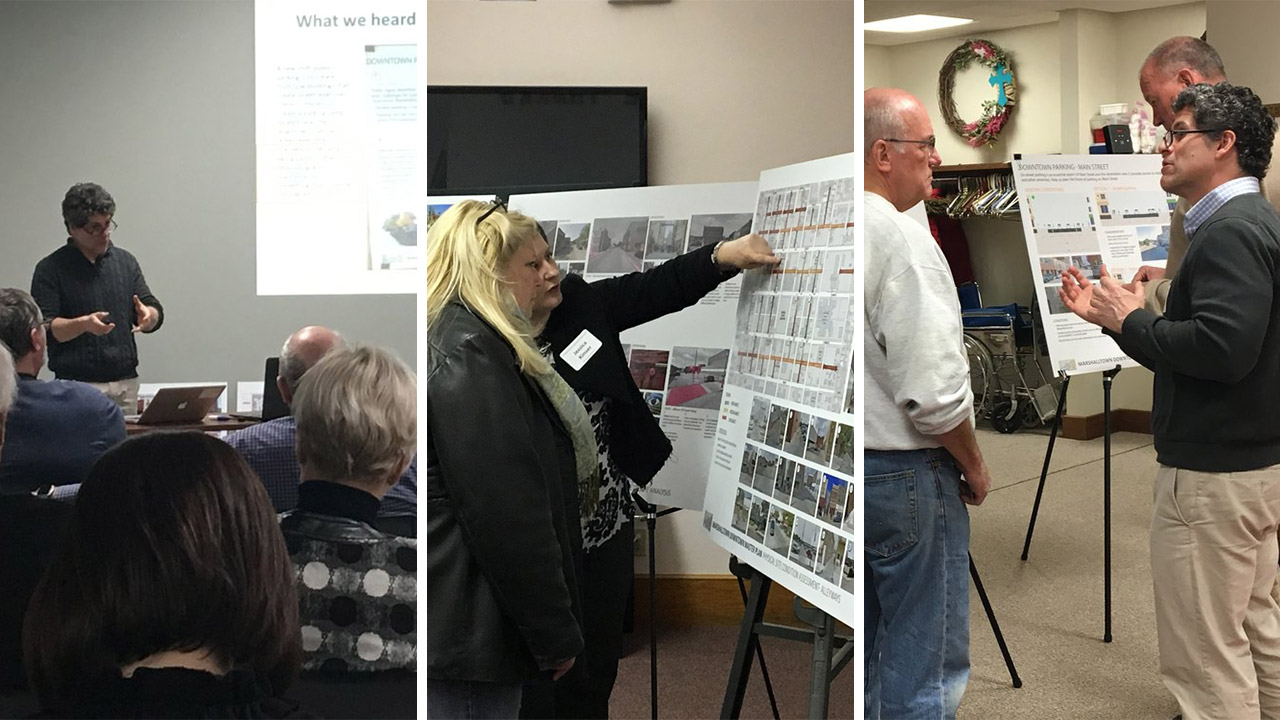
At any given point during the four-day charrette, the project team and steering committee had 15+ easels placed in the hallway near the work room in the City Council chambers – each representing a concept, idea and/or potential solution.
Every time the team had a new work product – for example, a building concept of a downtown park rendering with “green” features – it was printed and posted, allowing the public to react in real-time. Steering committee and team members were available around the clock to answer questions, provide clarity and seek feedback from, engage with and inform City residents.
It was encouraging and exciting to have the City and downtown stakeholders embrace the multi-day charrette process for developing the Downtown Marshalltown Master Plan. With some 1,500 people providing input online and more than 100 participating in focus groups, design sessions and review meetings – the plan truly provides a consensus vision for revitalizing and rebuilding downtown Marshalltown.
– Bob Kost, Downtown Marshalltown Master Plan project manager
8 key components of an impactful design charrette
The following list shares key components of the Marshalltown charrette. While specific to this project, these eight components are integral to making any charrette process valuable, especially if you’re seeking meaningful engagement.
- Runs for multiple, consecutive days
- Establishes a working design studio/home base in the project area; accessible to the public
- Includes key consultant team members: planning, urban design and real estate market, among others
- Includes key community leaders: steering committee, officials and beyond
- Collaborative approach putting many hands on master plan development
- Includes discussions, presentations and hands-on workshops
- Features a defined and inclusive process for meeting all demographics
- Includes at least 3 community feedback loops
3 Feedback Loops Used in the Marshalltown Charrette Process
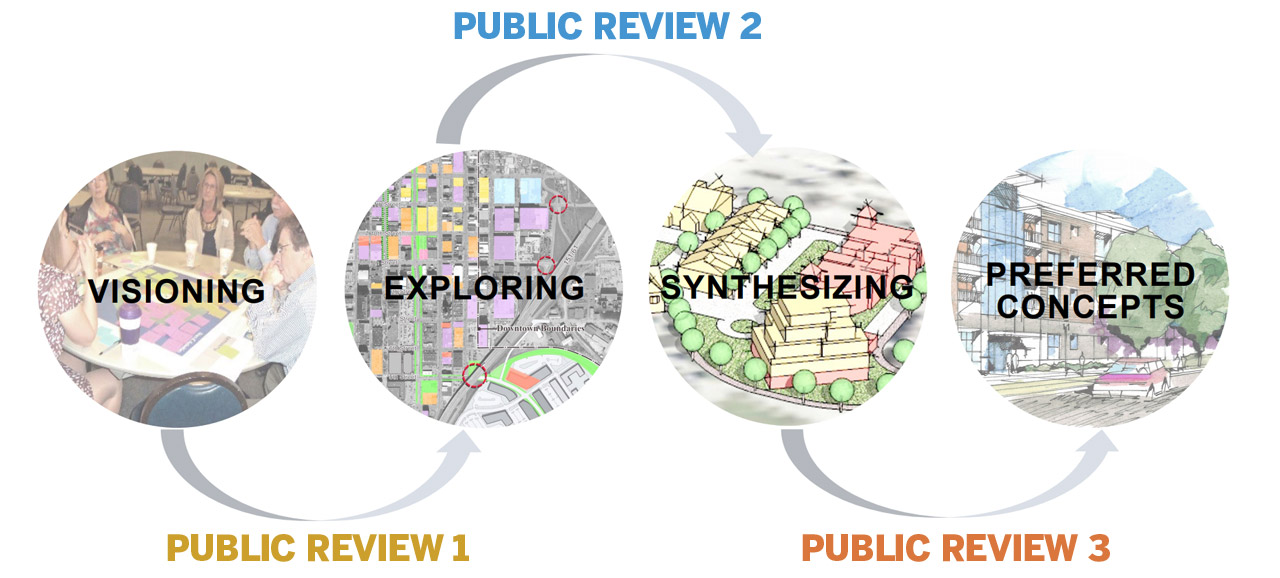
Outcomes of the Marshalltown charrette process
The project team developed master plan goals that took into account the community’s rebuilding goals, community residents’ desires and “catalyst” opportunities (projects that would invigorate the local economy). The following outcomes were developed and worked into the final plan based on what they learned during the charrette and public engagement efforts, as well as historical and market research:
- Design standards including direction, support and groundwork for future adoption of enhanced building design guidelines; aiding preservation, quality construction and long-term economic impact.
- North pocket neighborhood cottage homes; defined as a “neighborhood within a neighborhood” and involves clustering homes in close proximity to one another.
- One-way to two-way street conversions for safety, accessibility and more.
- Streamlining downtown parking to simplify and streamline parking regulations.
- Entertainment gateway including dining, rental properties and spaces for artwork.
- Green space including fountains, shade structure, shade trees, rain gardens/flower beds and interactive public art playgrounds.
- Pocket parks to potentially play host to concerts, kids programming, play spaces and more.
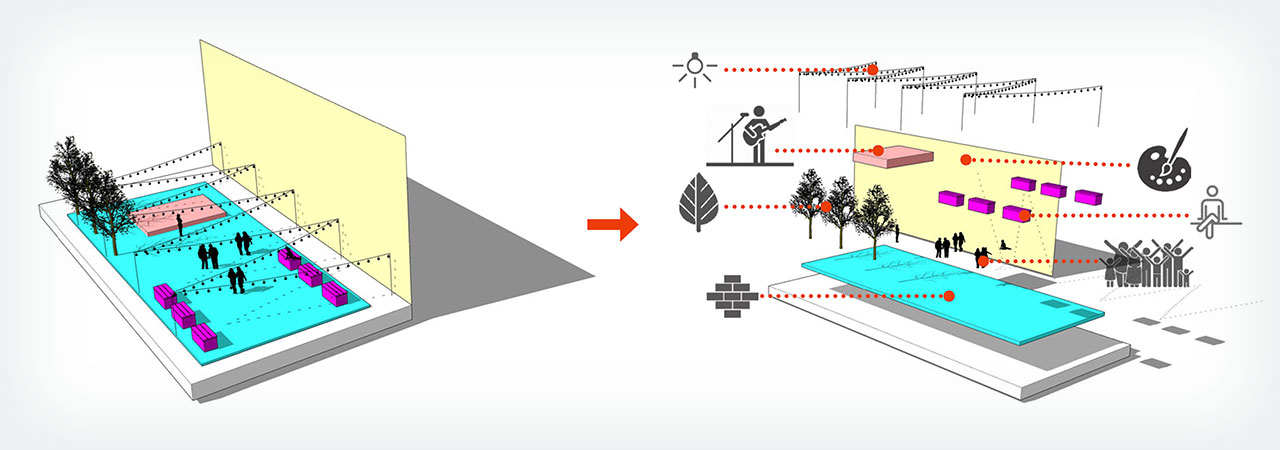
3. Letting community leaders take the lead
The importance of letting community leaders take the lead at times cannot be understated. This six-month process wouldn’t have been possible without a truly involved, hands-on partnership between City staff, the steering committee and the SEH team. The steering committee was present at all meetings, took time out of their full-time jobs to be available and engaged, and remained responsible and accountable for all aspects of the master plan as it came together.
It’s not uncommon for an A/E firm to develop and present a finished master plan to community leadership. This can work, but the SEH team recognized the need for a more involved approach. In fact, City staff – with the support and advocacy of steering committee members – presented the final plan to City Council for acceptance. Having all steering committee members engaged and deeply knowledgeable of the plan throughout the planning process was instrumental in gaining the confidence and buy-in of the City Council and community as a whole.
The people of Marshalltown really stepped up and participated in the master planning process. City staff did a great job of getting everyone involved. It was the citizens’ input and feedback that made the plan possible and so valuable to the community. Preserving and restoring the character of the buildings downtown was one issue that was important to them, and that was prominently reflected in the master plan.
– SEH streetscape and public space lead
One year later
Master planning began during the back half of November 2018, with the final master plan being delivered six months later in May 2019. The fully accepted Downtown Marshalltown Master Plan was presented to the public in June 2019, and the City Council unanimously began adopting the plan in its entirety in July – one year after the tornado struck.
Today, Marshalltown has a master plan they believe in and has begun rebuilding with confidence. This is primarily because City staff and the community were invested in its creation from the very beginning, remained accountable to one another throughout the process, and continue to pick each other up day after day.
For the businesses that have been able to open, it’s been really fun to see they’re all busier than they were before. We were just darn lucky … Everything seems to be working out really well for everybody.
– Joel Greer, Mayor, City of Marshalltown


